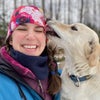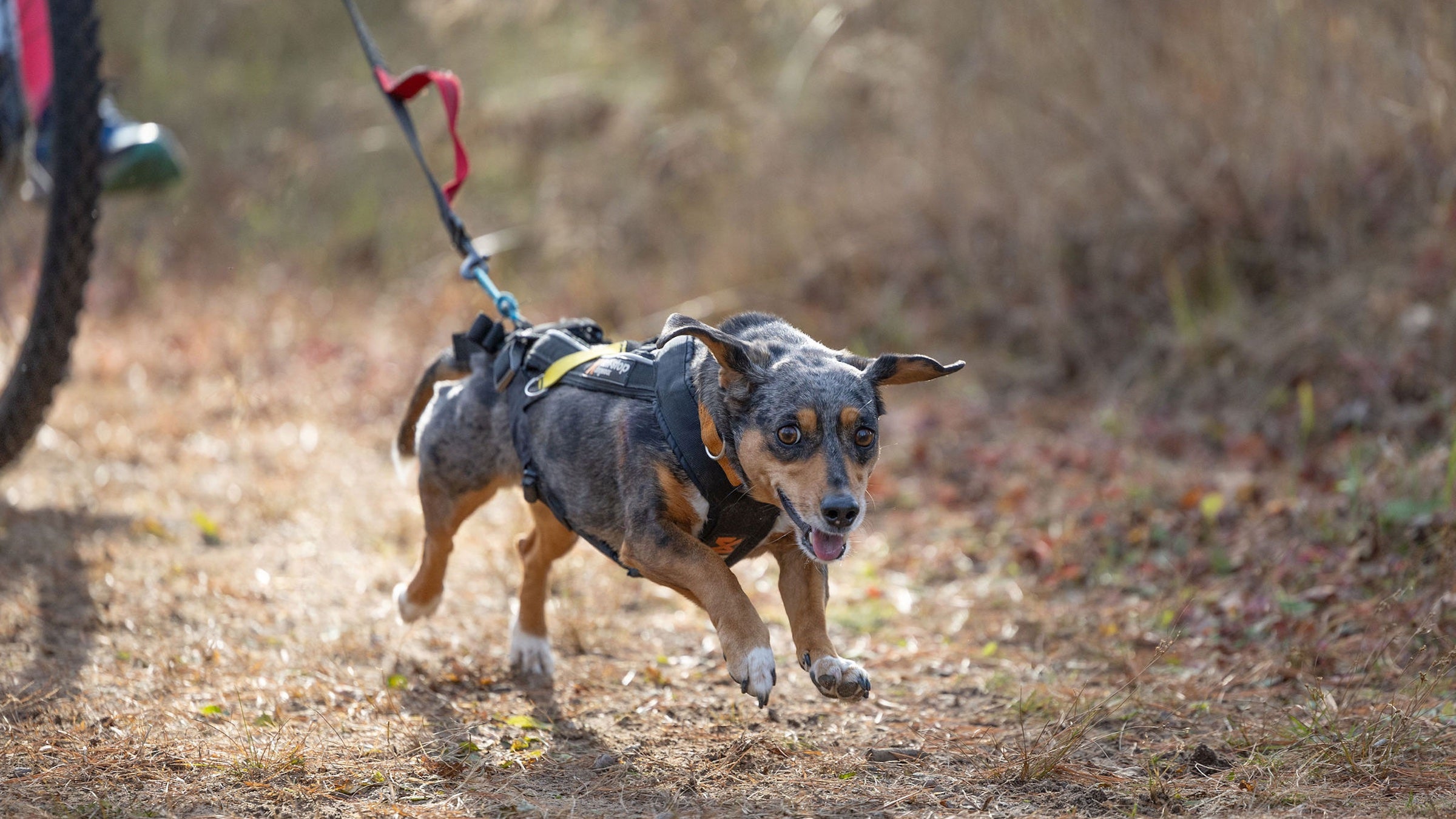Last fall, at a dryland dogsled race in Pearson,Wisconsin, one canine athlete stood out from the rest. While her competition—mostly pointers and Alaskan huskies—ran one- to three-mile sprints, then rested, she entered multiple divisions in such quick succession that she once hurried straight from the finish line to the starting line without slowing down. Her gaze is stoic. Her fur is orange. Her legs are four inches long.
Musher Betsy Heidt of Wausau, Wisconsin, didn’t plan for her 18-pound dachshund mix, Muppy, to become one of the most recognizable sled dogs in the Midwest. As it turns out, that was all Muppy’s idea.
“I could never get Muppy to walk on a leash,” Betsy told me over the phone. (I’m a dogsledder myself, and cheer for Muppy at races, but I don’t know Betsy well; I reached out to learn the full story.) “Someone commented that I should walk faster, so I walked faster, and then Muppy started running, so I started running, and then she started running faster. I don’t have the cardio for that, so I hooked her up to a bike and off she went. I was like, oh, I guess this is a thing.”
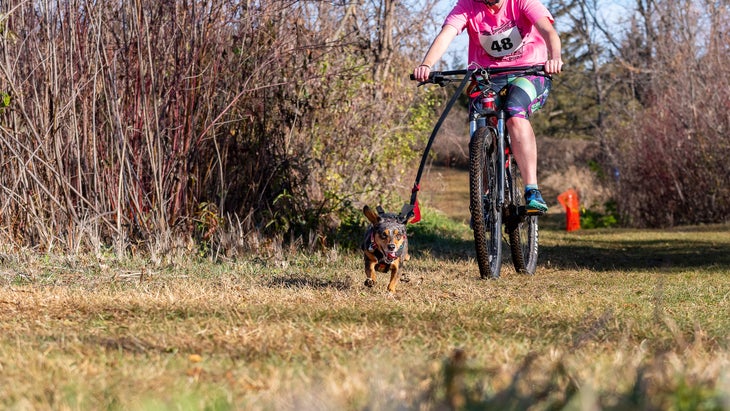
Betsy grew up on a dairy farm in the southern part of the state. As a kid, she sometimes hooked up the farm collies to a plastic sled with bailer twine, then threw snowballs for them to chase so they’d pull her. But those experiments, plus the movie Snow Dogs, were the only context she had for sled dog sports. So she turned to YouTube for urban mushing tutorials, which explained the basics of , , and : dogs pulling bikes, scooters, and human runners, respectively. The videos were helpful, but geared toward folks with huskies and other big dogs. They didn’t address many of the problems she encountered, like that Muppy was so short that she had to swim through puddles. Plus, where do you find a good harness that size?
But Muppy loved pulling so much that Betsy was determined to figure it out. She contacted a harness company called , ordering their smallest adjustable size, and got some goggles so that Muppy’s eyes were protected from sticks and burdock. They trained on deer trails in the woods by their house. Muppy was ecstatic to pull, and her never-ending energy felt like magic—even when she turned to chase critters, and Betsy went flying. “I got really good at reading her body language,” she told me. “I can tell by the way she holds her tail if she’s locked into something ahead of us, whether it’s a person in the distance or an unsuspecting rabbit.” Betsy learned to brace herself, and Muppy learned not to swerve: “She throws into the harness even more to get out that frustration.”
When Muppy was four, in 2021, Betsy posted a picture on Facebook, and a page called Twin Cities Dog-Powered Sports liked her post. “I sent some messages to their page, asking them 900 different questions, and they were super helpful.” When she saw that they were hosting a first-time race in Minnesota, she signed up for the 1.3 mile bikejoring event. She was terrified.
For one thing, Betsy didn’t know if other mushers would accept her. “But my biggest fear,” she said, “was that someone would pass us.” That summer, Muppy had been attacked by three golden retrievers at a park, and she’d been sketchy around strange dogs ever since. How would she react to a team coming up behind them? Betsy made a plan: if another team approached, she would veer off-trail and sit on the ground, holding Muppy, until they were gone. As it turned out, she and Muppy both had so much adrenaline—“We were pedal to the metal!”—that no other teams came close. They finished the course in just five and a half minutes, averaging over 14 miles per hour. The duo didn’t make the podium, but they weren’t on the bottom, either.
After that, they were hooked.
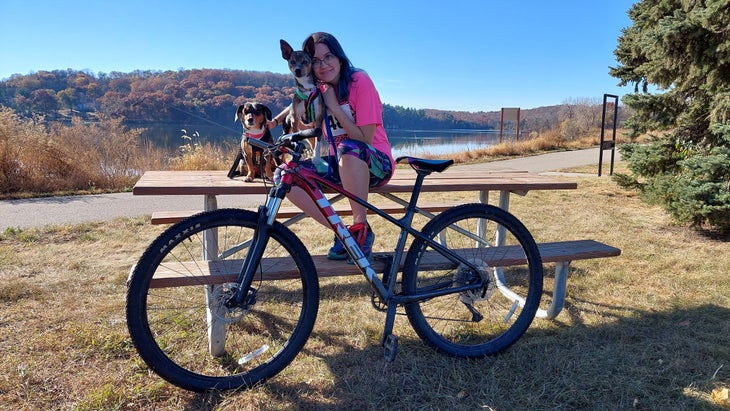
When most people picture sled dogs, they imagine huskies racing 1,000 miles through snowy wilderness. But in dryland racing, an ever-growing corner of the sport, teams consisting of one to six dogs compete in parks, cities, and small towns worldwide. Mushers gather at trailheads and parking lots for long weekends of racing, with world-champion sprinters (often huge, muscular pointers with legs a mile long) competing alongside teams of purebred Siberians and assorted mutts. When Betsy and Muppy first started showing up at races, people assumed that Muppy belonged to a spectator, or that she was a pet accompanying another team. But it wasn’t long before they took her seriously, as both a friend and competition.
Muppy’s not the fastest dog on the race circuit, but she’s among the most recognizeable, and crowds will sometimes gather to chant her name. The affection is mutual: there’s a bar on the country road that leads to one of the race sites, and whenever Betsy makes the turn in her car, Muppy starts screeching with excitement. In the starting chute, while the judge counts down, she wails, eyes glued to the trail ahead—and the moment Betsy releases the brake, they take off at top speed. She’s become a pro at some of the more technical aspects of racing, like getting passed—or, just as often, passing. “The dog parts of the other team, sometimes they just stare as they’re running, trying to decide if she’s food or friend,” Betsy recalled, laughing. “And their mushers will say, ‘Come on, Snowball! You’re getting passed by a wiener dog!”
For the past four years, during dryland season, Muppy races frequently, and trains by pulling Betsy or her husband two to three miles up to four times a week. Betsy works at a composting facility, and even brings Muppy to work sometimes, so she can practice running up and down the compost rows—which smell enticing, making them perfect practice for resisting distraction. Until this year, winter’s been Muppy’s off-season; she spends the snowy months digging and shredding sticks. But Betsy recently bought a fatbike, and the duo have been training for fatbikejoring races on snow.
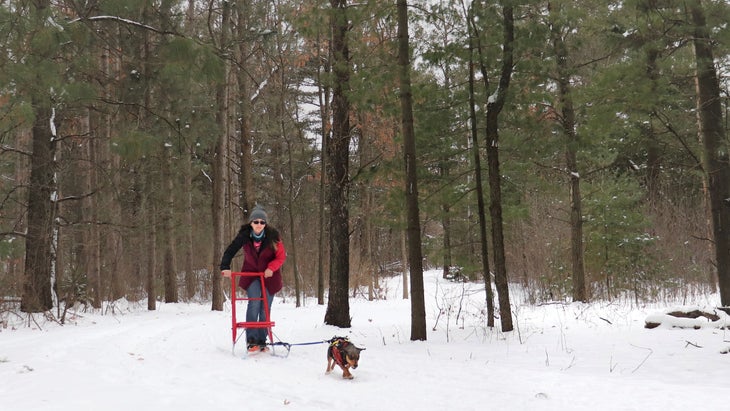
Last May, Betsy and her husband adopted a second dog, Journey, who’s a terrier-shepherd mix. Journey’s bigger than Muppy, and not that into pulling, but she does love running, so sometimes they enter two-dog races together. Muppy pulls, and Journey simply runs alongside her. Betsy doesn’t mind. The point of dog-powered sports, as she sees it, is to make dogs’ lives richer, and that means embracing each dog’s skills and interests—so as long as Journey’s happy, she’s happy too.
As for Muppy, she’s fully embraced her role as an icon; she prances when fans call her name. Betsy’s thrilled to be her ambassador. “If someone has a pet with boundless energy, a sport like this is a great opportunity for them,” she told me. “Even for a dog who doesn’t pull a lot, like Journey, being out in front and making decisions seems to tucker her out more than games of fetch ever did.”
But Betsy’s favorite thing has been seeing how much joy and inspiration Muppy’s athleticism brings to people. “I want to show that little dogs can do things,” she said proudly, “and help more dogs live enriching lives!”

